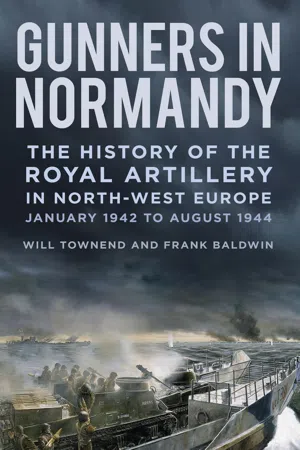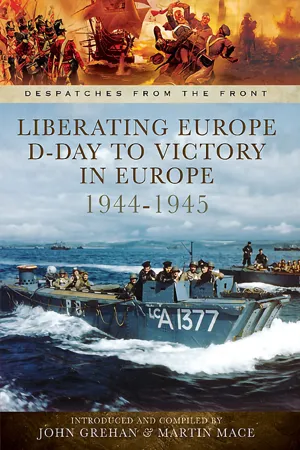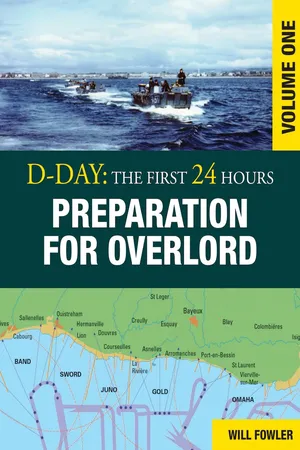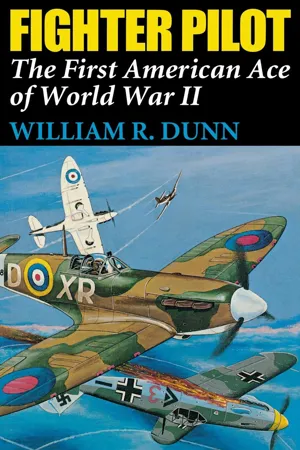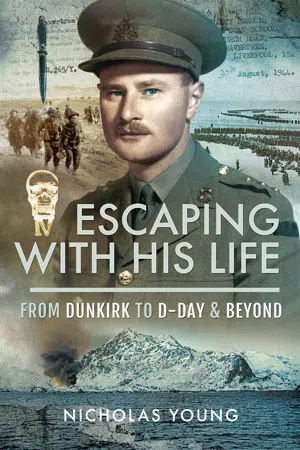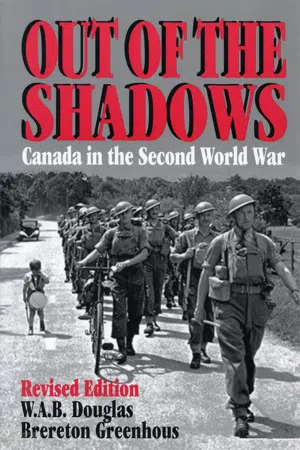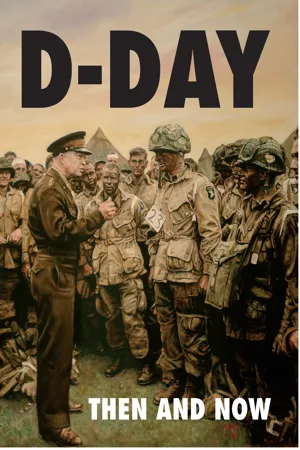History
Operation Overlord
Operation Overlord was the codename for the Allied invasion of Nazi-occupied Europe during World War II. It began on June 6, 1944, with the D-Day landings on the beaches of Normandy, France. Led by General Dwight D. Eisenhower, the operation marked a turning point in the war and ultimately led to the liberation of Western Europe from Nazi control.
Written by Perlego with AI-assistance
Related key terms
Related key terms
1 of 4
Related key terms
1 of 3
10 Key excerpts on "Operation Overlord"
- Richard P. Hallion(Author)
- 2014(Publication Date)
- Tannenberg Publishing(Publisher)
D-Day 1944 — Air Power Over the Normandy Beaches and Beyond
June 6, 1944
Operation Overlord, the Normandy invasion—like William the Conqueror's before it or the Inchon landing afterwards—will long be studied as a classic in military planning, logistics, and operations. OVERLORD depended to a remarkable degree upon the use of air power in virtually all its forms. A half-century ago, aircraft were primitive vehicles of war compared to the modern attackers of the Gulf War era, with their precision weapons, advanced navigational, sensor systems, and communications. Yet, the airplane still had a profound impact upon the success of the invasion. Simply stated, without air power, Normandy would have been impossible.Planning for OVERLORD
By D-Day, June 6, 1944, the Allies had been planning for the invasion of Europe for more than two years. In August 1943, the Combined Chiefs of Staff had approved the general tactical plan for the invasion, dubbed OVERLORD. General Dwight D. Eisenhower, Commander of the European theater since February 1944, would be responsible for carrying off this bold gambit. The Allies' main strategy, in Eisenhower's words, was to. . . land amphibious and airborne forces on the Normandy coast between Le Havre and the Cotentin Peninsula and, with the successful establishment of a beachhead with adequate ports, to drive along the lines of the Loire and the Seine rivers into the heart of France, destroying the German strength and freeing France.The Allies believed that the enemy would resist strongly on the line of the Seine and later on the Somme, but surprisingly, once ground forces had broken through the relatively static lines of the bridgehead at Saint-Lô and inflicted heavy casualties on enemy troops in the Falaise Pocket, Nazi resistance in France disappeared. British and American armies swept east and north in an unimpeded advance which brought them to the German frontier and the defenses of the Siegfried Line.- eBook - ePub
War Stories III
The Heroes Who Defeated Hitler
- Oliver North, Joe Musser, Joe Musser, Joe Musser(Authors)
- 2012(Publication Date)
- Regnery History(Publisher)
CHAPTER 11 Operation Overlord: NORMANDY 1941 Our landings in the Cherbourg-Le Havre area have failed to gain a satisfactory foothold and I have withdrawn the troops. My decision to attack at this time and place was based upon the best information available. The troops, the air, and the Navy did all that bravery and devotion to duty could do. If any blame or fault attaches to this attempt it is mine alone. T hat was the kind of message no general would ever want to send. It meant that Operation Overlord—the biggest military maneuver ever conducted—had failed. General Dwight David Eisenhower penned the brief communiqué by hand on a small sheet of notepaper late on 5 June 1944, and put it in his pocket. He knew that the monumental effort to cross the channel and breach Hitler’s Atlantic Wall across Normandy’s beaches was that uncertain. Eisenhower was supreme allied commander and he shouldered that responsibility. He kept the note with him throughout D-Day, 6 June, and all of the next day. Thankfully, it remained in his pocket. Overlord, a name chosen by Prime Minister Winston Churchill, had been in the planning stages for more than two years. Churchill had done all in his power to delay or even avert the operation altogether—fearing a repeat of the carnage the British army had endured in the trenches of France during World War I - eBook - ePub
Gunners in Normandy
The History of the Royal Artillery in North-west Europe, January 1942 to August 1944
- Frank Baldwin, Will Townend(Authors)
- 2020(Publication Date)
- The History Press(Publisher)
1
Background to Overlord
Even though large tracts of Europe and many old and famous States have fallen or may fall into the grip of the Gestapo and all the odious apparatus of Nazi rule, we shall not flag or fail. – Winston Churchill, 4 June 1940The Beginnings
The campaign to liberate Europe can be traced back to June 1940, and the period when Britain, its Empire, and Dominions stood alone. For the next four years the Western Front was defined by the Channel and North Sea, which offered no scope for other than anti-aircraft or coastal artillery units to see action. However, individual Gunners played a significant role in the events that led to D-Day and the Normandy campaign.With seventy years of hindsight, the success of Operation Overlord may appear inevitable. Yet it was very a risky operation. The English Channel is a formidable obstacle. Some of the most powerful armies of all time have baulked at making an opposed Channel crossing. Throughout British military history, British expeditionary forces typically entered the continent through friendly ports. British expeditions to an occupied shore usually failed dismally, as at La Rochelle, Saint-Malo, Walcheren and Bergen op Zoom in the eighteenth and nineteenth centuries. The twentieth-century experiences of Gallipoli, Dar es Salaam and Diego Suarez (now Antsiranana) were hardly encouraging. The development of the plans that lead to the success of Operation Overlord were in the hands of two senior gunner officers. General Sir Alan Brooke (the future Field Marshal Lord Alanbrooke), as the Chief of the Imperial General Staff (CIGS), was Churchill’s senior military advisor and shaped the timing and command of D-Day. Lieutenant General F.E. Morgan, as the Chief of Staff to the Supreme Allied Commander (Designate) (COSSAC), would play a key role in determining that D-Day would take place in Normandy, and the plans for this most complex and successful operation. - John Grehan, Martin Mace(Authors)
- 2014(Publication Date)
- Pen & Sword Military(Publisher)
6
OPERATIONS IN NORTH-WEST EUROPE
FROM 6TH JUNE, 1944, TO 5TH MAY, 1945.
The War Office,September, 1946The following despatch was submitted to the Secretary of State for War on 1st June , 1946, by Field Marshal The Viscount Montgomery of Alamein, G.C.B., D.S.O .I arrived in England on 2nd January, 1944, after handing over command of the Eighth Army, and immediately started a detailed study of the plans for the assault of the Continent – Operation Overlord.The Commander-in-Chief of the Allied Naval Expeditionary Force was Admiral Sir Bertram Ramsay and of the Allied Expeditionary Air Force, Air Chief Marshal Sir Trafford Leigh-Mallory. There was no parallel appointment of Commander-in-Chief of the Allied land forces, but General Eisenhower decided that I should act in that capacity for the assault, and subsequently until the stage was reached in the development of our operations when a complete American Army Group could be deployed on the Continent. No definite period was stipulated for this, but Headquarters Twelfth United States Army Group were formed in London and prepared to take command of First and Third United States Armies at the appropriate time. This Army Group, when formed, remained under any operational control until 1st September: when the Supreme Commander took over direct control of the land battle.The assault was an operation requiring a single co-ordinated plan of action under one commander; I therefore became the overall land force commander responsible to the Supreme Commander for planning and executing the military aspect of the assault and subsequent capture of the lodgement area.In the initial stages, the object of Operation Overlord was to mount and carry out an operation to secure a lodgement on the Continent from which further offensive operations could be developed.The troops under my operational control comprised 21 Army Group and First United States Army (General Omar N. Bradley). 21 Army Group comprised First Canadian Army (Lieutenant-General Crerar), Second British Army (Lieutenant-General Dempsey), the British Airborne Troops (Lieutenant-General Browning), and various Allied contingents. Attached to First United States Army were the American 82 and 101 Airborne Divisions. Ninth United States Air Force planned with First United States Army, while Second British Army worked with Second Tactical Air Force, R.A.F.- eBook - ePub
- Will Fowler(Author)
- 0(Publication Date)
- Amber Books Ltd(Publisher)
Men and equipment are off-loaded from a US landing craft on a beach in Devon during a training exercise. The beaches of Devon were chosen for their similarity to the beaches of Normandy, with their long, sloping sands running gently into the sea.CHAPTER ONE
THE ROAD TO OPERATION OVERLORD
The Americans pressed for an invasion of Northern Europe as early as 1942, but it would take two more years for the plans and training to reach fruition. US, British, Canadian troops and men and women from the occupied countries of Europe were now massed on a crowded island, as the Allied air forces pounded communications and defences in preparation for the invasion. Now these soldiers awaited the order to go.BY THE SPRING OF 1944, the Western Allies and the Soviet Union knew that the war in Europe was moving, at times slowly, towards the defeat of Nazi Germany and her partners. However, they had not always enjoyed this confidence.In September 1939, under its leader Adolf Hitler, Nazi Germany attacked Poland, and France and Britain declared war. Poland fell in a month. To secure her northern flank, Germany then invaded Denmark in April 1940 and had a tough and costly fight for Norway. In June that year, the defeat of France followed after a six-week ‘blitzkrieg’ (‘lightning war’) campaign. France was divided into a Nazi-occupied north and west and a southern ‘neutral’ pro-Nazi Vichy zone. In April 1941, Germany and her allies overran Yugoslavia in 11 days. Greece fell after a tough fight, and by the end of May, German paratroopers had seized the island of Crete. The Soviet Union was still bound by a 1939 non-aggression treaty it had signed with Nazi Germany, while the United States, though sympathetic to Britain, was reluctant to become embroiled in a European conflict. In the spring of 1941, Britain stood alone.German gunners back fill sand and soil against the concrete gun pit of a 15cm (5.9in) K 18 gun in a coastal artillery position. On the right they are putting turf in place to landscape the pit, which is camouflaged from the air by a netting frame suspended over the gun. - eBook - ePub
Fighter Pilot
The First American Ace of World War II
- William R. Dunn(Author)
- 2014(Publication Date)
- The University Press of Kentucky(Publisher)
But this is the year 1944! Much has happened since the Nazi triumphs of 1940–41. The United Nations have inflicted upon the Germans great defeats, in open battle, man-to-man. Our air offensive has seriously reduced their strength in the air and their capacity to wage war on the ground. Our Home Fronts have given us an overwhelming superiority in weapons and munitions of war, and placed at our disposal great reserves of trained fighting men. The tide has turned! The free men of the world are marching together to Victory!I have full confidence in your courage, devotion to duty and skill in battle. We will accept nothing less than full Victory! Good luck! And let us all beseech the blessing of Almighty God upon this great and noble undertaking.”The paper was signed by General Dwight D. Eisenhower, Supreme Commander, AEF. (I still have the copy I was given that morning of 6 June 1944, a treasured memento to remind me of those desperate and glorious days.)“Well I’ll be damned,” said I, “Ike really means it. Today we finally go–but couldn’t he have picked some better weather for the beginning of our great and noble crusade? It’s raining like hell; even the ducks are walking.” According to the latest bulletin on the weather board I noted the clouds were solid from 1,500 to 15,000 feet in our part of England.“Maybe it will blow over before dawn,” commented L.C. “Let’s get to work on this frag. We haven’t got too much time before we all become heroes.”The frag order for “Operation Overlord,” the code name of the invasion plan, listed a large number of fighter groups assigned the mission of beach cover that day, all in timed relays so that fighter support for the ground troops would be immediately available. There were a lot of new code words to be memorized. Special communications between air groups, naval ships, and army units had been set up, as well as lateral communications between the Allied forces landing on the several designated invasion beach areas. Recce photos of the Normandy battle zones were studied so that we could positively identify our assigned patrol area. Antiaircraft defenses–ours–were plotted on maps. Anyone who flew into those defense zones, friend or foe, would be shot at. Orders were issued to Captain Wilbur Smallwood, the group armament officer, to rapidly up-load the required munitions–machine gun ammo and rockets–on our aircraft. Major Larkin, intelligence officer, dug through his files to compile all enemy reaction data available. Group operations was soon a madhouse, activity of all sorts being generated to prepare the 406th for its D-Day participation. A full-scale briefing of all pilots was now scheduled for 3 a.m. - eBook - ePub
Escaping with His Life
From Dunkirk to D-Day & Beyond
- (Author)
- 2019(Publication Date)
- Pen & Sword Military(Publisher)
Chapter 21
Operation Overlord
B y the end of D-Day, all five of the landing beaches had been taken by the Allies, but connecting them up took another six days, and none of four towns that were to have been captured on D-Day itself (Carentan, St Lo, Caen and Bayeux) had been taken. Although the German defensive line along the Channel coast was incomplete, and the Allied deception plan had been successful in causing confusion about the timing and location of the invasion, the Allies themselves faced difficulties in coping with the narrow roads and bocage countryside of Normandy, with its landscape of small fields enclosed by high banks, deep ditches and thorny hedges. Furthermore, Caen itself, which was a key road and rail junction, was strongly defended, and Montgomery’s chosen tactic of encircling it to the west, rather than risk a direct assault, was criticized as allowing the Germans vital time to build up their defences.Within a week, all hope of the swift capture of further ground in northern France disappeared, and what remained was weeks of grim attrition, as the Allies fought to wear down the defending forces in a series of tactical manoeuvrings over small meadows and copses and through a succession of ruined villages.Leslie, meanwhile, was somewhere in England, being held in reserve and probably chafing at the bit to get back into the fight. On 30 June, D+23, his name was finally called, and he boarded a requisitioned ferry and crossed the Channel, escorted by a small protective naval convoy and preceded by a minesweeper. They were heading for the Mulberry Harbour at Arromanches, newly-constructed from concrete prefabricated sections towed across the Channel in the wake of the invasion fleet, and he went ashore there the following day, to join a million Allied troops already fighting in France.The scene as he landed was awe-inspiring. At sea, dozens of warships patrolled the Channel and the Normandy coast and approach routes, maintaining a regular bombardment on enemy positions inland; closer in, dozens of block ships had been sunk, their funnels and masts protruding from the sea, whilst scores of cargo ships lay offshore, protected by barrage balloons, awaiting their turn to tie up and unload at the encircling concrete arms of the Mulberry Harbour, or to disgorge their cargo of supplies, weapons, tanks and ammunition on to the countless landing craft that scuttled to and from the beaches. The rapidly-growing Allied army required more than 20,000 tons per day just to keep it in action, and the pace could not be allowed to flag. From troopships, mostly commandeered ferries, more landing craft brought hundreds of men ashore by the hour, day and night, returning to the UK filled with wounded soldiers by the score, or with file upon file of dejected German prisoners. - eBook - ePub
- Jonathan Bastable(Author)
- 2018(Publication Date)
- Greenhill Books(Publisher)
Chapter 1Operation Overlord
On 4 June 1940, a few weeks after becoming prime minister, Winston Churchill spoke to parliament and the people of Great Britain. He gave one of the best speeches of his life – perhaps one of the finest speeches ever made in the English language. At its climax he said:We shall fight them on the beaches; we shall fight on the landing grounds; we shall fight in the fields and in the streets; we shall fight in the hills; we shall never surrender.The beaches and hills Churchill had in mind were the beaches and hills of southern England. The British army had just been ignominiously driven out of France at Dunkirk. The Nazi war machine was twenty-five miles away on the French coast, and so the prime minister was preparing his people for the worst. He was telling them that Britain was about to be invaded.That invasion never came – and yet Churchill’s words were prophetic. Four years to the day after he spoke them, a massive invasion force lay in wait in English harbours, ready to take the fight back to the Germans. But now the beaches were the beaches of Normandy. And the fight was not the latest phase in Germany’s expansion, but the beginning of the end of Nazi power in Europe.The Distant Second Front
The battered troops of Dunkirk were barely out of their wet clothes when Churchill began thinking about sending them back as conquerors. But at that time there was no prospect at all of hitting back at Hitler. He controlled all mainland Europe. Britain – his only declared enemy – was weak and badly bruised. ‘Britain fights alone,’ said Churchill, and even he struggled to make it sound as if this was a good thing.Events took some hopeful turns in the course of 1941. In March, US President Franklin D Roosevelt declared that it was in the best interests of the United States to support Britain in its lonely war. He undertook to provide Britain with every kind of aid – short of military muscle. In June, Hitler made his biggest mistake of the war. He attacked the Soviet Union, bringing down upon Germany the immense wrath and the countless legions of the Russian people. The Russian war became an all-consuming passion for Hitler, and for a while he turned his malevolent and baleful gaze to the east, away from Britain. - eBook - ePub
Out of the Shadows
Canada in the Second World War
- Brereton Greenhous, W.A.B. Douglas(Authors)
- 1996(Publication Date)
- Dundurn Press(Publisher)
CHAPTER 7
Operation Overlord
Planning for the invasion of northwest Europe may be said to have begun in October 1940, when the Joint Planning Sub-Committee of the British chiefs of staff first considered the problems involved in returning to the continental mainland from which the BEF had so recently and rudely been ejected. When the United States entered the war, in December 1941, the principle of an invasion through France had been confirmed. Indeed, the Americans thought it might be mounted in late 1942, but a British refusal to consider it at that time (unless the Russian front looked like totally collapsing) compelled them to think again.The Americans next argued for an attack in 1943, but the British remained chary of mounting a premature assault and, as we have seen, were more interested in reaffirming their influence in the Mediterranean theatre. Bowing to British experience, their new allies reluctantly accepted the postponement of a cross-Channel assault in favour of the attack on Sicily and, subsequently, Italy.In March 1943, however, an Anglo-American planning staff began to consider in detail the strategy and logistics of invading France. The requirement for air cover from fighters limited the possible area of assault to the French and Dutch coasts between Cherbourg and Flushing. The Dieppe experience had taught that the attack should probably not be launched through a port – but not every beach would be suitable. Such technical considerations as tides, beach slopes, roads, and regional topography soon narrowed the possibilities to two main areas: the Pas de Calais or the Baie de la Seine.In many ways the Pas de Calais was the most suitable, but for those very reasons it was also where German defences were strongest. The Baie de la Seine, on the other hand, was much more lightly defended and the port of Cherbourg lay nearby, to the west, where a short thrust across the base of the Cotentin peninsula would isolate it from further reinforcement. At the eastern end of the Bay, albeit on the other side of the Seine estuary, lay Le Havre – the second largest port (after Marseilles) of pre-war France. - eBook - ePub
D-Day Volume 1
Then and Now
- Winston Ramsey(Author)
- 1995(Publication Date)
- After the Battle(Publisher)
Operation ‘Overlord’ By General Dwight D. Eisenhower SUPREME COMMANDER, ALLIED EXPEDITIONARY FORCEIn early December, I had received word that the President would return to the United States through our area. I went to Tunis to meet him. During the remainder of the afternoon, we made arrangements to conduct the President to Malta and to Sicily.A few hours before his arrival, I received a somewhat garbled radiogram from General Marshall that discussed some administrative details incident to my forthcoming change in assignment. When he wrote the message, General Marshall apparently assumed that I had already received specific information concerning the new assignment through staff channels. But, lacking such information, I was unable to deduce his meaning with certainty. The President arrived in mid-afternoon and was scarcely seated in the automobile when he cleared up the matter with one short sentence. He said: ‘Well, Ike, you are going to command “Overlord”.’Because I had to discuss with him, at once, details of his next day’s plans, we had no opportunity, at that moment, to talk further about the new assignment; but I did manage to say: ‘Mr. President, I realize that such an appointment involved difficult decisions. I hope you will not be disappointed.’During his visit, the President on several occasions discussed matters in connection with my imminent transfer to London. He was quite concerned with two points that did not seem particularly important to me. The first of these was the timing of the announcement. It was finally decided that the President would do this from Washington; in the meantime, my change in assignment would be a closely-guarded secret. The second point was my title as commander of ‘Overlord’. He toyed with the word ‘supreme’ in his conversation but made no decision at the moment. He merely said that he must devise some designation that would imply the importance the Allies attached to the new venture.
Index pages curate the most relevant extracts from our library of academic textbooks. They’ve been created using an in-house natural language model (NLM), each adding context and meaning to key research topics.
Explore more topic indexes
Explore more topic indexes
1 of 6
Explore more topic indexes
1 of 4
![D-Day 1944 - Air Power Over The Normandy Beaches And Beyond [Illustrated Edition]](https://img.perlego.com/book-covers/3020494/9781782898870_300_450.webp)

